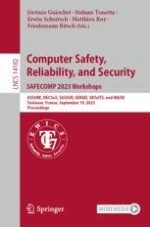This book constitutes the proceedings of the Workshops held in conjunction with SAFECOMP 2023, held in Toulouse, France, during September 19, 2023.
The 35 full papers included in this volume were carefully reviewed and selected from 49 submissions.
- - 8th International Workshop on Assurance Cases for Software-intensive Systems (ASSURE 2023)
- - 18th International Workshop on Dependable Smart Embedded and Cyber-Physical Systems and Systems-of-Systems (DECSoS 2023)
- - 10th International Workshop on Next Generation of System Assurance Approaches for Critical Systems (SASSUR 2023)
- - Second International Workshop on Security and Safety Interactions (SENSEI 2023)
- - First International Workshop on Safety/ Reliability/ Trustworthiness of Intelligent Transportation Systems (SRToITS 2023)
- - 6th International Workshop on Artificial Intelligence Safety Engineering (WAISE 2023)
